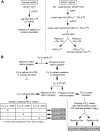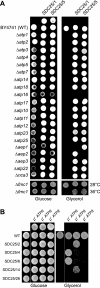A genetic screen targeted on the FO component of mitochondrial ATP synthase in Saccharomyces cerevisiae
- PMID: 21454598
- PMCID: PMC3093890
- DOI: 10.1074/jbc.M110.214825
A genetic screen targeted on the FO component of mitochondrial ATP synthase in Saccharomyces cerevisiae
Abstract
In yeast, the two main F(O) proton-translocating subunits of the ATP synthase (subunits 6/a and 9/c) are encoded by mitochondrial DNA (mtDNA). Unfortunately, mutations that inactivate the F(O) typically result in loss of mtDNA under the form of ρ(-)/ρ(0) cells. Thus, we have designed a novel genetic strategy to circumvent this problem. It exploits previous findings that a null mutation in the nuclear ATP16 gene encoding ATP synthase subunit δ results in massive and lethal F(O)-mediated protons leaks across the inner mitochondrial membrane. Mutations that inactivate the F(O) can thus, in these conditions, be selected positively as cell viability rescuing events. A first set of seven mutants was analyzed and all showed, as expected, very severe F(O) deficiencies. Two mutants carried nuclear mutations in known genes (AEP1, AEP2) required for subunit c expression. The five other mutations were located in mtDNA. Of these, three affect synthesis or stability of subunit a transcripts and the two last consisted in a single amino acid replacement in subunit c. One of the subunit c mutations is particularly interesting. It consists in an alanine to valine change at position 60 of subunit c adjacent to the essential glutamate of subunit c (at position 59) that interacts with the essential arginine 186 of subunit a. The properties of this mutant suggest that the contact zone between subunit a and the ten subunits c-ring structure only involves critical transient interactions confined to the region where protons are exchanged between the subunit a and the c-ring.
© 2011 by The American Society for Biochemistry and Molecular Biology, Inc.
Figures





Similar articles
-
A "petite obligate" mutant of Saccharomyces cerevisiae: functional mtDNA is lethal in cells lacking the delta subunit of mitochondrial F1-ATPase.J Biol Chem. 2006 Jun 16;281(24):16305-13. doi: 10.1074/jbc.M513805200. Epub 2006 Apr 11. J Biol Chem. 2006. PMID: 16608846
-
Suppression of a nuclear aep2 mutation in Saccharomyces cerevisiae by a base substitution in the 5'-untranslated region of the mitochondrial oli1 gene encoding subunit 9 of ATP synthase.Genetics. 1999 Apr;151(4):1353-63. doi: 10.1093/genetics/151.4.1353. Genetics. 1999. PMID: 10101162 Free PMC article.
-
Modular assembly of yeast mitochondrial ATP synthase.EMBO J. 2011 Mar 2;30(5):920-30. doi: 10.1038/emboj.2010.364. Epub 2011 Jan 25. EMBO J. 2011. PMID: 21266956 Free PMC article.
-
Insights into ATP synthase assembly and function through the molecular genetic manipulation of subunits of the yeast mitochondrial enzyme complex.Biochim Biophys Acta. 2000 May 31;1458(2-3):428-42. doi: 10.1016/s0005-2728(00)00092-x. Biochim Biophys Acta. 2000. PMID: 10838056 Review.
-
Assembly of F0 in Saccharomyces cerevisiae.Biochim Biophys Acta. 2009 Jan;1793(1):108-16. doi: 10.1016/j.bbamcr.2008.07.001. Epub 2008 Jul 11. Biochim Biophys Acta. 2009. PMID: 18672007 Free PMC article. Review.
Cited by
-
The depletion of F₁ subunit ε in yeast leads to an uncoupled respiratory phenotype that is rescued by mutations in the proton-translocating subunits of F₀.Mol Biol Cell. 2014 Mar;25(6):791-9. doi: 10.1091/mbc.E13-02-0112. Epub 2014 Jan 22. Mol Biol Cell. 2014. PMID: 24451261 Free PMC article.
-
Mitochondrial translation initiation machinery: conservation and diversification.Biochimie. 2014 May;100(100):132-40. doi: 10.1016/j.biochi.2013.07.024. Epub 2013 Aug 14. Biochimie. 2014. PMID: 23954798 Free PMC article. Review.
-
Ancestral State Reconstruction of the Apoptosis Machinery in the Common Ancestor of Eukaryotes.G3 (Bethesda). 2018 May 31;8(6):2121-2134. doi: 10.1534/g3.118.200295. G3 (Bethesda). 2018. PMID: 29703784 Free PMC article.
-
Assembly-dependent translation of subunits 6 (Atp6) and 9 (Atp9) of ATP synthase in yeast mitochondria.Genetics. 2022 Mar 3;220(3):iyac007. doi: 10.1093/genetics/iyac007. Genetics. 2022. PMID: 35100419 Free PMC article.
-
Regulation of mitochondrial translation of the ATP8/ATP6 mRNA by Smt1p.Mol Biol Cell. 2016 Mar 15;27(6):919-29. doi: 10.1091/mbc.E15-09-0642. Epub 2016 Jan 28. Mol Biol Cell. 2016. PMID: 26823015 Free PMC article.
References
-
- Boyer P. D. (1997) Annu. Rev. Biochem. 66, 717–749 - PubMed
-
- Ackerman S. H., Tzagoloff A. (2005) Prog. Nucleic Acids Res. Mol. Biol. 80, 95–133 - PubMed
-
- Senior A. E., Nadanaciva S., Weber J. (2002) Biochim. Biophys. Acta 1553, 188–211 - PubMed
-
- Abrahams J. P., Leslie A. G., Lutter R., Walker J. E. (1994) Nature 370, 621–628 - PubMed
Publication types
MeSH terms
Substances
LinkOut - more resources
Full Text Sources
Other Literature Sources
Molecular Biology Databases

